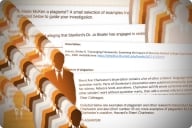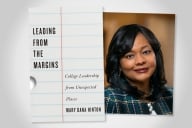You have /5 articles left.
Sign up for a free account or log in.
At the beginning of Free Speech on Campus (Yale University Press), the co-authors recount a seminar they taught at the University of California, Irvine, on the topic of free speech on campuses. They asked their students if the University of Oklahoma was justified in expelling some students and punishing a fraternity after video surfaced of fraternity members chanting that black people (whom they referred to with the N-word) would never be allowed to join the fraternity.
The freshmen at Irvine voted 15 to zero to say that expulsion was justified.
The authors are Erwin Chemerinsky, who wrote the book as law dean at Irvine and is now in that role at the University of California, Berkeley, and Howard Gillman, chancellor and professor of law, political science and history at Irvine. They recount that, throughout their seminar, they had students vote on how colleges were handling issues that related to free speech and hateful speech. Week in and week out, the students voted in favor of "stopping and punishing offensive speech."
Chemerinsky and Gillman write, "This generation has a strong and persistent urge to protect others against hateful, discriminatory and intolerant speech, especially in educational settings."
Their book is pro-free speech and opposes calls to keep various offensive speakers off campus. So are two other books being published this month, one with the same name as Chemerinsky and Gillman's work.
The other books are Free Speech on Campus (University of Pennsylvania Press), by Sigal R. Ben-Porath, professor of education, political science and philosophy at the University of Pennsylvania, and Safe Spaces, Brave Spaces: Diversity and Free Expression in Education (MIT Press), by John Palfrey, head of school at Phillips Academy, Andover, and formerly professor and vice dean at Harvard Law School.
All three books review some of the controversies of the last year and touch on the history of free speech in American society. But while the books would back the right of Charles Murray or Ann Coulter to appear on campuses, the authors of all three works criticize the way students have been mocked as "coddled," and suggest that the best way to promote free speech on campus is to engage in the discussions prompted by students opposed to some speakers.
Palfrey writes, for example, of the "cottage industry" of pundits who mock students as "crybullies" or "snowflakes," and who take "cheap shots" rather than consider the students' legitimate concerns about the impact of various campus events on students who are female, minority, gay or in some way the subject of rudeness or worse from visiting speakers.
That freedom of speech should be upheld, he writes, doesn't mean that the students don't have real issues to consider.
Chemerinsky and Gillman write that "much of the criticism of current students and their sensibilities fails to reflect the laudable compassion that motivates them," adding that "mocking these students or treating their concerns as pathological misses the mark."
So what should college leaders do?
A common theme is that colleges shouldn't end the discussions about controversial events or statements just by saying that principles of free speech are essential. They need to do more, the books say.
Ben-Porath writes about the concept of "inclusive freedom," in which colleges affirm not only free speech, but also "an inclusive environment," in which people from all perspectives and groups are respected.
One way to do that is not to just sit back and let events happen, she writes. At Penn, Ben-Porath has served as an "open expression monitor," part of a team of people who can be invited to observe and intervene as necessary during appearances by controversial speakers who might set off a denial of free speech rights. These monitors work to make sure events are not shut down, but also to ensure that students who may be offended or angered by a speaker have the ability to ask questions or express their views, without themselves being shouted down.
Palfrey writes of the role of colleges in inviting a range of speakers to campus and not just letting one group dominate the public discussions.
Chemerinsky and Gillman write that it's important to teach students, not just be upset about what they don't know.
"The historic link between free speech and the protection of dissenters and vulnerable groups is outside the direct experience of today's students, and it was too distant to affect their findings about freedom of speech," they write. "They were not aware of how the power to punish speech has been used primarily against social outcasts, vulnerable minorities and those protesting for positive change -- the very people toward whom our students are most sympathetic. Their perception of speech is shaped more by internet vitriol than by the oppression of Eugene Debs, Anita Whitney, John Thomas Scopes, Jehovah's Witnesses who refused to say the Pledge of Allegiance, leftists during the McCarthy era …"
Chemerinsky and Gillman also write of how colleges can take actions that may prevent hateful situations without violating anyone's rights. For example, they note that living spaces on campus are important to students' well-being. If a campus is experiencing a problem with offensive decorations of dormitory rooms or windows -- say, flying the Confederate flag -- it can ban all decorations on windows. Banning the flag alone would not be legal at public institutions, but banning everything should be. (They went to press before Ohio State University adopted a policy exactly like they suggest.)
Similarly, they write that permitting all forms of speech doesn't mean campus leaders can't speak out against hateful ideas, and thus provide support to various students.
Post-Charlottesville
One disadvantage for the authors of all three books is that they went to press before the recent violence in Charlottesville, Va., where white nationalists not only marched, chanting Nazi sayings, on the campus of the University of Virginia, but held a rally in the city of Charlottesville, where one attendee is accused of driving his car into a group of those protesting the white nationalists' racism, killing one.
Via email the authors shared their views about how these recent incidents have changed (or not changed) their views.
Palfrey wrote, "I don't see what happened there as a free expression matter. I see it as about violence and racial hatred that has no place on our campuses or in our town squares."
Ben-Porath said, "In the current atmosphere, establishing and maintaining an environment of inclusive free speech on campus can permit avoiding the threat of violence coming from some groups -- in this sense, some universities took an appropriate step recently when they decided not to rent their facilities to [Richard] Spencer [one of the organizers of the Charlottesville white nationalist demonstration]. This is relatively easy when we think of outside groups looking to come to campus."
To Chemerinsky, the issues of free speech haven't changed since the book went to press. But he said that the question of guns also needs to be addressed. "There is no right to have guns or other weapons at demonstrations," he said. "Campuses can and should prohibit them at demonstrations. They obviously are not part of discourse and create greater risks of violence."
And for Gillman, the recent events point to the need to promote free speech in ways that also assure the safety of the campus, which he said can be done.
"There are a variety of steps campuses can and should take to ensure safety, beyond prohibiting weapons and other tools for rioting," he said. "They can insist on venues where it is easier to control crowds, ensure ingress and egress, establish security checkpoints, and keep disputing groups apart. If such venues are not available on the preferred date and time of a sponsoring group, then groups must be willing to work with campuses to find a mutually satisfying time, with the understanding that campuses can't pick a date and time that is designed merely to prevent audiences from attending. (In other words, no speaker has a right to insist on a particular venue at a particular time.)
"Campuses can also use required ticketing as a way to control access. But all steps must be tried to make sure that the mere threat of violence is not used as an excuse to prevent certain views from being expressed in campuses. As we argue in the book, any idea must be expressible on a campus without censorship or punishment."
Added Gillman, "Campuses should be battlegrounds for the exchange of ideas, but can never be allowed to become actual battlegrounds."








